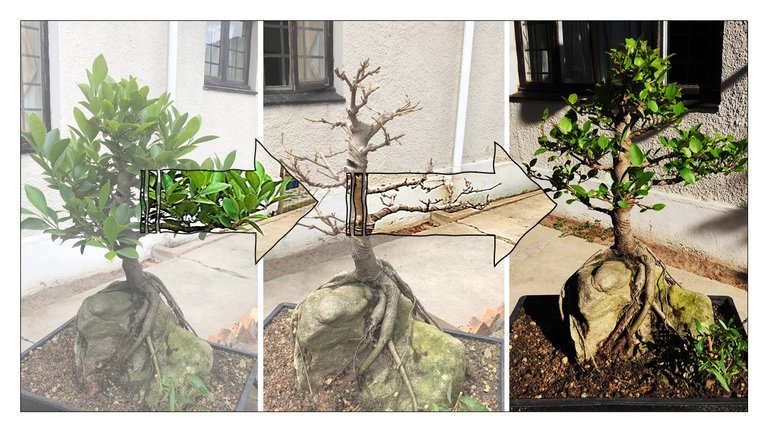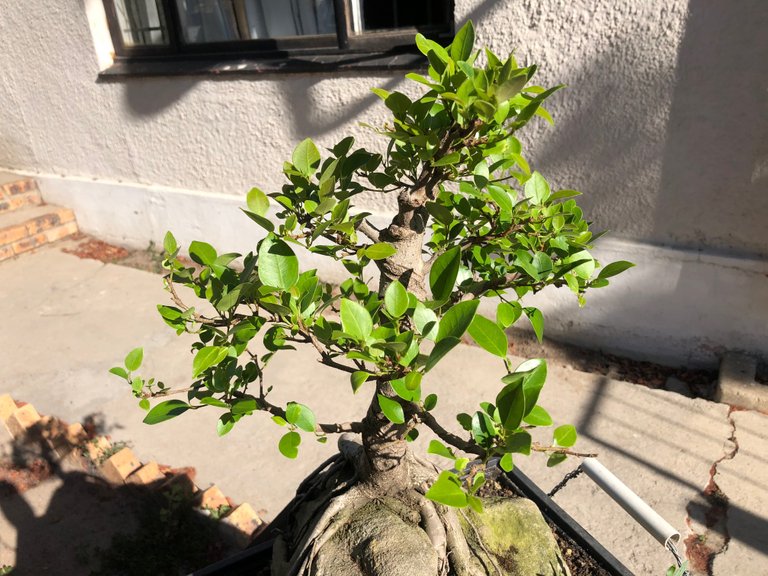
Happy belated new years to all the #steemit guys and gals. Hope you had an eventfull festive season and that you could use this time to rest so that you are ready for 2020.
In my last blog I mentioned that I defoliated a Ficus tree in November 2019. I did not want to post any blogs on the progress as I wanted the tree to recover before I shared the trees journey with you. I took a few photos before and after the tree was defoliated and also a few during the defoliation process. I posted some of these photos at the bottom of my previous blog. I will be sharing what defoliation is and ending off with a brief look at the tree before and after defoliation.
Before I jump into the trees progress let's just take a moment to discuss defoliation. What is defoliation? Defoliation is the removal of the leaves from a tree. This can be done in one of two ways. You could use a pair of scissors or you could individually remove the leaves by hand. Once you decided on the technique that suites your application best you can move on to defoliated the tree. You could remove all the leaves of the tree at once or you could remove the leaves selectively. The second option is normally used if the growth on the tree is stronger on one part of the tree or if you want the leaves on one part of the tree to reduce in size in relation to the rest of the tree. Yes, you heard me right defoliation reduces the size of the leaves on the tree. The reduction of the leave size differs between tree species. Here is a example of the reduction in the leaf size of the Ficus tree I worked on.

The leaf in my hand is a leaf off a tree that comes from the same batch of Ficus' as the one that I defoliated. The bigger leaf is much greener as it is a fully matured leaf. The ones on the tree are light green as they are newly formed, they might grow a few more millimeters but not much more in size. They will soon start changing into a darker shade of green. The leaves on the tree is about a 1/4 (quarter) of the size of the leaf in my hand.
Defoliation also helps with ramification and back budding. When you remove the leaves from all the branches of the tree you're allowing the sunlight to penetrate the parts of the branches that would other wise not receive any sunlight. This then stimulates the flow of growth hormones in the branch and new growth will start sprouting from these areas. Here are a few examples of new growth that was stimulated in the Ficus I worked on.


If you look closely at the two photos you will see the multiple new branches . The new branches will be the ones that are light green in color and has no bark on then yet. The next step in this process will be to selectively prune the tree. I will be doing this by removing the branches that grow into the wrong direction and also by removing unwanted forks in the branch. I will only leave two branches at each split in the branch. By removing the additional growth I eliminate the unsightly bulges that occur when multiple branches stem from one point.
What trees respond well to defoliation? In my experience deciduous trees are the trees that respond the best to defoliation. The technique can be used on evergreen tree species as well but not all species get the same results some trees might die so please use caution when apply this technique on species that your not sure if it will be successful. Consult your local nursery and inquire about tree species that they know responds well to defoliation. Timing of defoliation also plays a important role. I defoliate in summer. I try not to defoliate to late in the summer season as I have had deciduous trees keeping their new growth straight through winter and this set them back severely in the following spring. This might not be the case in your region. In the Western Cape, South Africa our winters are cold and wet but temperatures generally do not drop below freezing so deciduous trees that have been prune or defoliate to late in the growing season might keep their new growth on the tree well into winter.
Now that you know a bit more about the process let's see how I implemented it on the Ficus tree. I will be showing the photos that I took during the process in sequence.
Before I start with any tree I normally have to remove the weeds and clean up the growing container.


Once that was done I started defoliating the lowest branch first and like any other work done on my trees I work my way up the tree.




After that was done the tree was moved to a slightly more shaded area to recover. After a week or so I start moving it back to a spot that receives more sunlight. Slowly the tree starts developing new growth. Roughly 14 days (two weeks) after defoliation the tree had new grow all over the tree.
Here is the tree five weeks later.



The tree should have a fully covered canopy in the next two weeks. After that I will just be pruning back the long shoots. This tree is well on its way to becoming a bonsai tree. I always try new techniques and experiment on apply the new techniques on the same species a different times in the season just to see when the tree responds best. Once I found the so called sweet spot I stick to it.
Hope you enjoyed my blog. If you have any comments of suggestion please feel free to leave them in the comments section provided below.
PS. If you found this article helpful please send me photos of trees that you defoliated.
One thing I learned from looking at your photos: Before defoliation, many large leaves are shading out lower leaves and branches. Eventually those hidden ones will weaken, I would guess. By defoliating the tree is caused the tree to form a more evenly distributed new canopy. All branches are forming equally healthy leaf tips.
However, I will give you credit for good branch pruning probably also aided the tree to rehabilitate a more even distribution. It is keeping those lower branches just as vigorous as the top younger ones.
Thank you for the well articulated feedback.
The tree looks much better with the smaller, more proportionate leaves. I have been wanting to defoliate my citrus tree for some time now but I didn't know when would be best and like you said, doing it improperly could kill it. I didn't know whether to do in the winter when it's indoors and gets less light or in the summer when I move it outdoors.
Thank you for your input.
I have not defoliated a citrus tree. It might be better to defoliate in summer when the tree is growing strong.
Seek advise from a local nursery and hear what they have to say about defoliating a citrus trees. Also find out what the best time will be to defoliate.
Thank you for your advice.